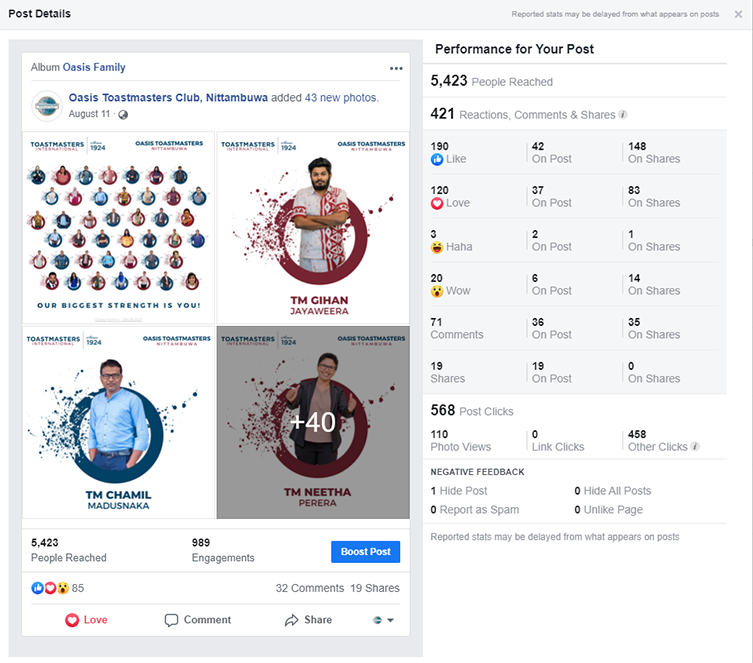
Is your club using social media to connect with prospective members? If not, is it because you’re not sure where to even start? Social media helps foster communication with club members and guests, and if used effectively, can be a member recruitment tool. Through social media platforms, you immediately connect with your audience.
How do you create content and successfully share your message? How often and on which platform should you post?
Alina Paul, DTM, of the Desert Pioneers Toastmasters in Salmiya, Kuwait, outlined five strategies in a social media workshop for District 20. Below are Paul’s strategies to effectively utilize your club’s social media along with advice from other social media savvy Toastmasters.
1 Set a goal and make a plan.
Ask yourself what your primary objective is. Does your club want to grow your followers or attract new members? “Keep in mind that goal when creating your strategy and sharing content,” says Paul. Your goal will change over time depending on your club’s needs, and therefore your strategy will also change.
Now, who is in charge of creating and sharing content for your club? An easy choice is the Vice President Public Relations (VPPR), but it could be another officer or member. Whoever is selected should get help from others. For example, ask one or two people to take videos or pictures during meetings, create design templates, or tackle other tasks as needed.
If you give multiple members access to the platforms, coordinate to keep consistency. Some elements in your posts should remain the same such as the Toastmasters logo, colors, and hashtags. Paul suggests having pre-designed templates. Consistency is key to ensure your audience recognizes your club’s posts and where they come from. Sticking to the Toastmasters International Brand Manual. will help.
2 Identify your target audience.
Your choice of platform depends on your audience demographic: Instagram has a younger, more active audience than Facebook or LinkedIn, according to a Pew Research study. While there is plenty of data on general social media demographics, Chamodith Ranasinghe, professional marketer and VPPR of Oasis Toastmasters in Nittambuwa, Sri Lanka, prefers knowing exactly who is viewing his club’s pages. He suggests distributing a questionnaire to the club to learn what mediums work best for your existing membership. Ranasinghe says, “This really helps not only understanding your members’ perspectives and expectations but also defining the key success factors for your club and areas of improvement.”
Of course, you need a social media account before you start identifying your audience. When creating an account for your club, be sure to make it a business account, not just a personal page. This will ensure you have access to page insights, which can only be accessed on business accounts and provide valuable information, including your followers’ most active times, locations, how they interact, pageviews, likes, etc.
Paul suggests reviewing these often. They are located on the profile page of your social platforms. Get to know who you are speaking to and consider who you are trying to reach. Knowing your audience will allow you to communicate effectively and achieve your goal.
3 Create strategic content.
Meeting details are good to share, but posting about members’ achievements, birthdays, contest times, and events can garner engagement.
Georgia Huntley, social media expert and member of the UofG Toastmasters in Guelph, Ontario, Canada, suggests defining three main topics for your posts—your “key content pillars.” Her club’s pillars are testimonials, working through Pathways, and ongoing club activities.
Sharing your club activities will inspire other members as well as showcase what your club does. Be positive and show how Toastmasters helps members grow, while having fun and building community.
Include photos of club members along with fliers and other graphics. Canva offers many free templates. For video editing, look at FilmoraGo or InShot.
Building a social media presence takes time and effort,
but can be rewarding if done strategically.
Depending on your platform, you will need to size images differently, and your captions may vary. On Instagram—a visually-driven platform—use less text and be more creative with your images. Huntley recommends portrait size images (1080 x 1350 pixels). “It takes up the most space on people’s feeds when scrolling through.” The images you post shouldn’t be cut off and it’s best that they are high quality and resolution.
On Facebook—a platform meant for social networking—posts are usually more descriptive. Even with more information, it’s important to engage your audience. A good way to grab their attention is to start your post with a question.
Huntley gives three valuable tips for writing posts on any social platform:
- Spend time writing your first sentence. Capture your reader’s attention immediately.
- Use hashtags to help followers find your posts. Huntley suggests up to 30 “smart” hashtags. These are words and phrases consistent to the content you are sharing. For example, #Toastmasters, #PublicSpeaking, #Leadership, #PersonalDevelopment.
- Keep it short and get to the point quickly. “Long-form captions are out,” says Huntley.
LinkedIn focuses on professional development, so try sharing achievements, leadership opportunities and tips, and members’ development. This platform aligns nicely with the professional nature of Toastmasters so if you want to create a paid advertising campaign, opt for doing it on LinkedIn. Toastmasters International created the LinkedIn Ad Guide for this purpose.
A paid advertising campaign requires a schedule, but you should create an agenda for your standard content as well. It is helpful to schedule your posts. Hootsuite is a tool that allows you to link social media accounts and set specific dates and times for your posts to go live. Organize your posts depending on the content, the platform, your goal, and your followers.
4 Encourage activity.
You want your followers to interact with your posts. Tag members so they can see your posts, and their friends and connections will see them too. Use a call to action and invite followers to share your content. Ask members to post on their personal channels about what is going on in your club and about their achievements. They could share a lesson learned at a meeting or a photo when preparing for a speech—remind them to tag the club account.
Another efficient tool for interactions is to ask questions or create polls. You could ask your audience what they would like to see more of or what information would be helpful to them. Your followers need to feel included.
Regularly check the performances of your posts. With the insights tab on your account, you can see the number of people reached, numbers of reactions, comments, shares, etc. This information also helps you discover the best times to communicate with your followers.
5 Get your members involved.
With the help of current members, the Oasis Toastmasters gained nine new members and supported 10 other prospective members with just one campaign!
Ranasinghe, the club’s VPPR, created an extensive social media and public relations plan to unite members and attract guests. He customized club members’ Facebook profile pictures using the Toastmasters logo and branding. Members shared it on their profile and gained traction with their Facebook friends. Ranasinghe says, “It’s all about word of mouth.”
The best way to gain visibility while improving your members’ engagement and energy is to get them involved in campaigns. Create a social media vote where members compete to be awarded best speech from social media followers. Be creative and check what other clubs are doing to get inspiration from them.

Building a social media presence takes time and effort, but can be rewarding if done strategically. Paul says, “Each post is a new learning experience.” By trying things out, like on stage, you discover what is working and what is not. You can then adapt your communication style.
So jump right in and start working on your social media strategy!
Editor’s Note: “Build a Social Media Presence” is an elective in Pathways Level 4.
Victoria Salem is a former member of the Covent Garden Speakers in London, England. A professional coach and networking expert, she helps individuals build better relationships so they can be more successful and create more opportunities for themselves. Learn more at tgncoaching.co.uk.
Related Articles

Personal Growth
Instagram Influencers in the Spotlight

Personal Growth
Build Your Brand to Last

Technology



 Previous
Previous

 Previous Article
Previous Article